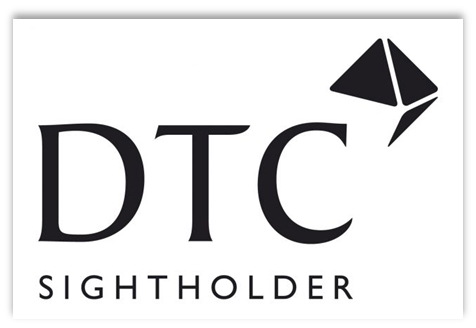DTC Sightholder Sales - How diamond supply system works?
I am sure you would have noticed the below "DTC Sightholder" logo on the ad copies of various jewelry brands. But, do you know what does it actually mean? If not, then you can go through this article. Here I have explained about DTC sightholder company, how sightholder diamond sales system works and what are the requirements for being appointed as sightholder.
But before that, I'll give you a brief background of De Beers that will set the context rolling for further understanding.
De Beers Background
De Beers is the world’s leading diamond company with unmatched expertise in the field of exploration, mining and marketing of diamonds. It's the world’s largest diamond producer by value, with its mining operations in Botswana, Canada, Namibia and South Africa. You may read more about De Beers.
DTC (Diamond Trading Company) is De Beers' rough diamond sales and distribution division with responsibility of selling De Beers rough diamonds. This trading arm sells De Beers diamonds, which is primarily done through two channels - Global Sightholder Sales and Auction Sales. With sightholder sales route being the heart of DTC's selling model, sales from it comprises 90% of De Beers’ rough diamonds by value.
Now, you would be thinking - what is sightholder?
What is DTC Sightholder Company?
A "Sightholder" is a company on the DTC's list of authorized bulk purchasers who buy rough diamonds from De Beers mines. These sightholders are among the world’s leading diamantaires from the major diamond centers (like India, Belgium, Israel etc.) around the globe. They comprise of varying business types - from large global manufacturers, to niche specialists, to vertically integrated businesses with retail operations.
Sightholders (also referred as De Beers clients) purchase rough diamonds at selling events (called "Sight") that are held once every five weeks (i.e. around ten times a year) in Botswana, Namibia and South Africa. At these sights, sightholders physically inspect rough diamonds before deciding whether to purchase them or not.
Functioning of DTC Sightholder system prior to year 2000
The De Beers name has been associated with diamonds since their modern day diamond discovery, and it quickly became the world's largest distributor of diamonds. This resulted into attaining monopoly in diamond business with control over more than 80% of the world's supply of diamonds.
With huge control on diamond supply, and rising demand for diamond, De Beers came up with a distribution method which involved invitation to sightholders to buy sealed boxes of rough diamonds. However, such was the control of De Beers on diamond trade, that sightholders were not even allowed to view the diamond roughs prior to purchasing.
In short, buyers used to be completely unaware of what they were buying. Reason stated was that, DTC had a good idea of what sizes and qualities the buyers needed, so they were accordingly offered that selection. Also, dealers were even encouraged not to purchase stones from any other source outside DTC's domain.
"Supplier of Choice" - Effect of changing times
Monopolistic approach throughout the twentieth century kept De Beers from certain business practices in the US and Europe. So, in order to change its image of dominating force, De Beers carried out a strategic review of diamond industry in late 1990s.
It was concluded that, in changing market scenario with emergence of fresh competition from new diamond producers, it was no more feasible and no longer in company's long term interest to dictate and physically control supply of rough diamonds. The final outcome of this review was "Supplier of Choice (SoC)" policy which was announced in year 2000 with its initial features introduced in 2002.
SoC to a large extent formalized - what was otherwise used to informal - commercial relationship between De Beers and its customers (sightholders), for buying and selling of rough diamonds. Major improvement from prior system was, the sightholders were now granted to inspect the stones before buying and were allowed to buy only the boxes that they applied for.
Another big change from the earlier supply arrangement was, sightholders were now awarded fixed-term contracts (typically 3 years) with all terminating simultaneously. Now, sightholders enter into SoC contract, and at the end of each contractual period, DTC reviews the customers' list. New contracts are awarded based on the outcome of detailed assessment of interested applicants.
DTC Sightholder Requirement
DTC's customer selection process - that take place at the start of each contract period - is quite rigorous and objective. Their basis of decision can be divided into following 3 criteria with level playing field for both existing (sightholders) and new applicants:
- Assessment: Customers are required to submit a Contract Proposal Questionnaire (CPQ) with their required details, like - financial standing, market position, manufacturing and distribution abilities, compliance with DTC's Best Practice Principles (BPPs) etc. Primary objective of this exercise is to get on board only those diamantaires who adopt strict ethical standards in their business practices and are capable of adding value to diamonds sourced from De Beers.
- Application: Clients are also required to submit application with details about type and volume of goods they would purchase from DTC over the next selling period (typically 12 months or 10 sights).
- Availability: Based on clients' requirements, DTC check the forecast availability of each category of rough diamond, and then compare and determine what and how much to sell to whom.
According to DTC, the amount of supply to each sightholder is ascertained by the sightholder’s relative score on its CPQ, along with DTC’s forecast availability in each category of rough diamonds.
De Beers is very particular about its brand name. So, in order to ensure De Beers diamonds are not associated with unethical business functioning of any sort, sightholders are strictly required to comply with De Beers' BPPs. If they are in any manner found inconsistent with the laid guidelines of BPPs, then DTC has right to terminate sightholder contract.
Note: Read this news article for updated rough allocation process for SoC contract period 2015-18: DTC has announced the updated rough allocation process for global sightholder sales (now non-sightholder businesses will also be permitted to purchase rough diamonds from sightholder sales).
Return from DTC Sightholder Sales to Diamond Articles page
Return from DTC Sightholder Sales to Diamond Jewelry Homepage
I hope you'll not mind sharing this on Twitter, Facebook and with everyone else :)
Feel free to share if something is in your mind and want it to be covered on this site.
My Newsletter
Did you liked this article? Sign-up my FREE weekly newsletter and I'll send you more awesome new additions on this website along with latest jewelry happenings around the world, and download my Jewelry Design Album for FREE!
 |
|



